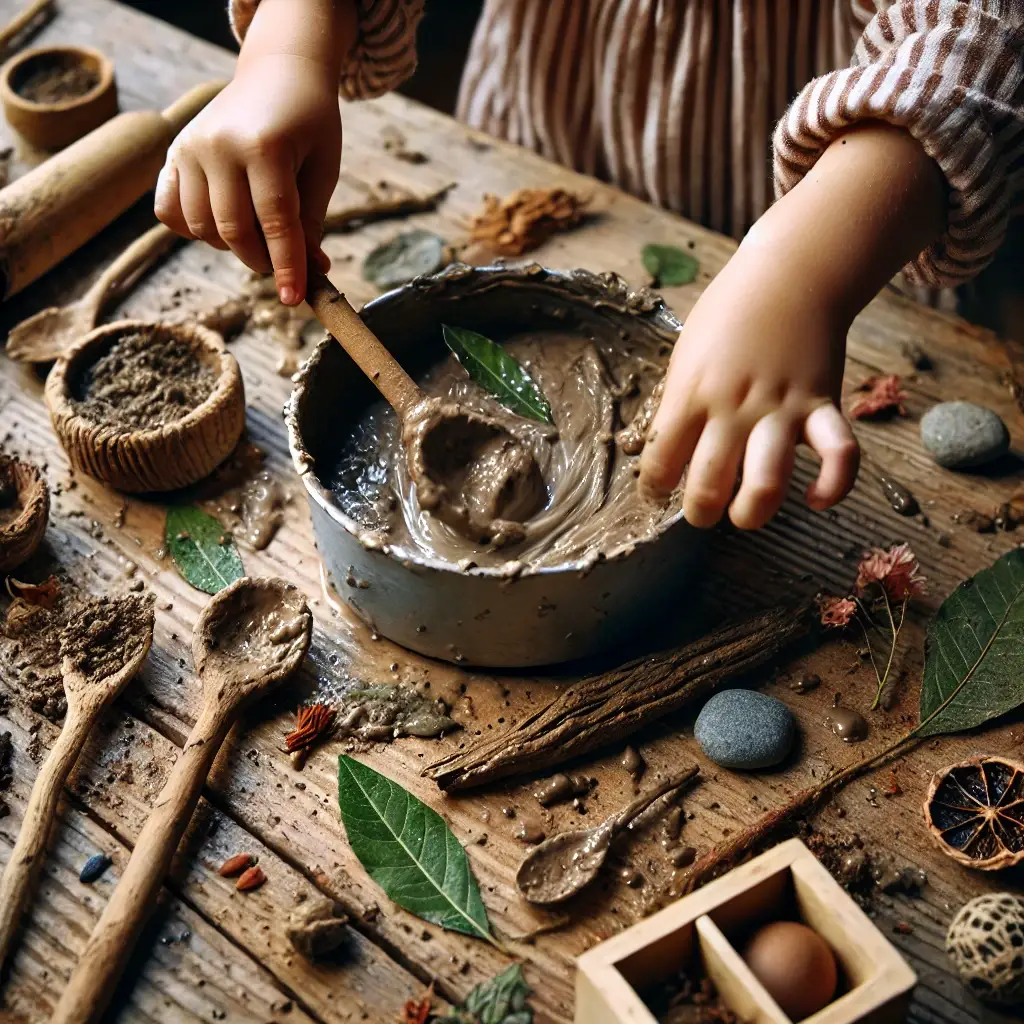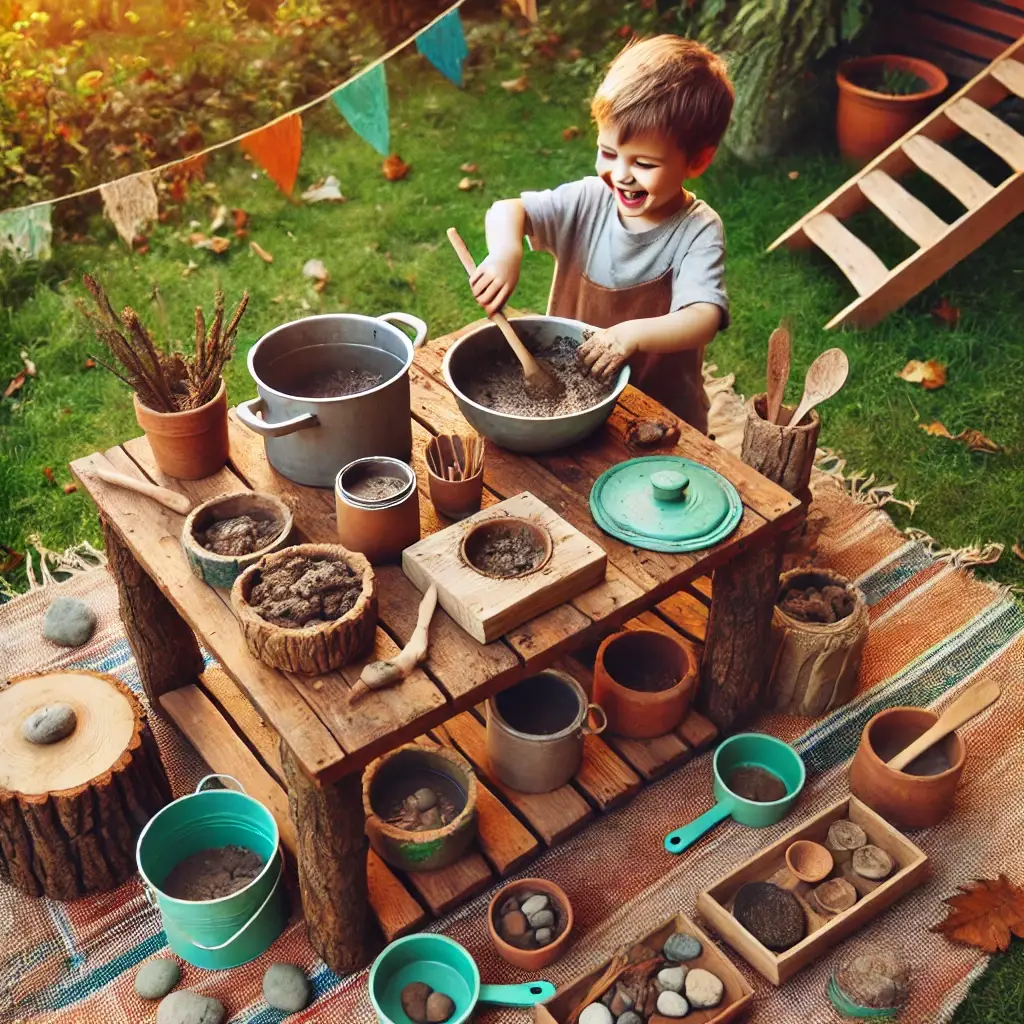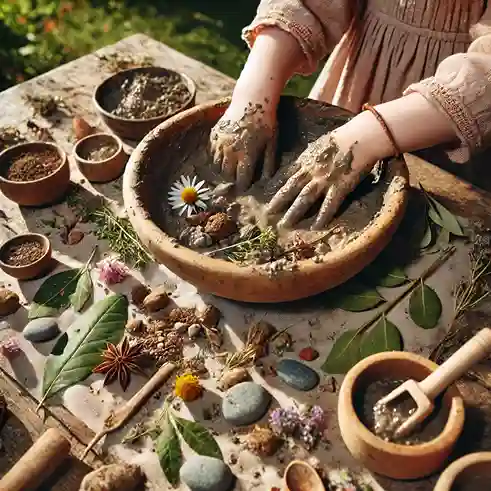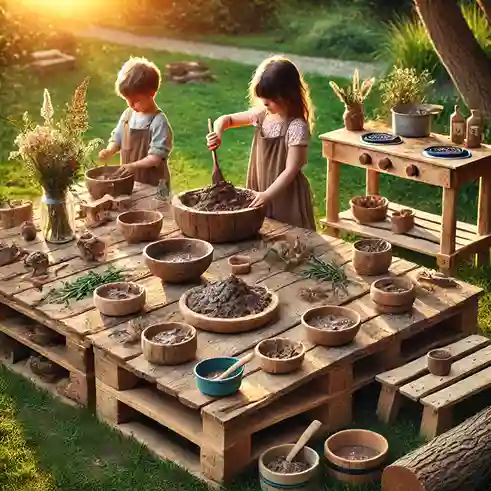Introduction to Mud Pie Kitchen
A mud pie kitchen might be one of the best places for children where they will get a chance to engage in creative activities and gain full sensory experience through the use of mud, water, and other organic components. This idea encourages children to explore their creativity by combining different textures, colors, and shapes to make their very own “mud pies” or other clays. The creative side of mud pie kitchen is not the only side to it, they offer countless possibilities for practical learning and development in different areas.
Making use of the outdoor space while also engaging in sensory play has previously proven to enhance a child’s creativity and imagination. This is because it gives them the liberty to play with the material by mixing and molding those freely. Such sort of play can also improve their problem-solving abilities as they deal with the difficult task of making their own creations. It enables them to use logical reasoning as to what materials will be perfect for them to make it, how they can be combined and what other tools would be necessary in order to accomplish such a task which all results in extensive learning.
In addition, mud pie kitchens encourage the children to play in unstructured settings which are crucial for a child’s growth. Unstructured play helps children to pursue their areas of interest and do activities on their own, which makes them feel self-reliant over what they do. This self-reliance is important because it motivates children to actively engage, make choices, interact with their peers and in the process, acquire social skills. Furthermore, implementing mud and other natural materials in this type of play adds that extra sensory component which is necessary for the child in psychomotor and psychological areas.
The construction of a mud pie kitchen for example allows caregivers to not only foster playful engagement but also assist in the process of dualistic growth of a child in an entertaining manner. Such outdoor play spaces can have a massive impact on the growth and experiences a child undergoes and equips them for the future.
Selecting The Most Suitable Site
Establishing A mud pie kitchen for children is a thrilling project that promotes creativity and stimulates the senses. However, a great deal of attention should, first and foremost be paid to proper arrangements of this mud kitchen. A few considerations are necessary in order to create a safe and pleasant setting.
To begin with, supervision zoning is a core requirement. For instance, the mud pie kitchen should be within sight of supervising adults to ensure children’s safety, but at the same time, give them some room to move about. This makes it possible for caregivers to observe what is happening and, if need be, step in so that play is safe and enjoyable.
Besides supervision, the choice about the region under assessment needs to be considered. It is much better to go to a place that is devoid of sharp edges, debris, or any form of dangerous items. Certain places are flat and stable to avoid the tendency of people tripping or falling. In addition, drainage is an aspect of concern where the site should not be where water will accumulate after rain or be muddy since it will make work less pleasurable for the children.
Moreover, while thinking about the position of the mud pie kitchen, one thumb rule should be to consider the advantages of sunlight versus those of shade. A sunny position satisfies snugness and helps to dry up mud pies which amends the experience. However, this needs to be weighed against unbearably hot conditions on some scorching days. Shaded spots on the other hand can provide succor during play times but also help in the drying process of the creations made.
The final factor is the site of the mud pie kitchen itself. And here, too, trees, gardens, or simply open areas do not only provide nice scenery, but also incite children to go outside and interact more with the environment. This is what enhances pretend play since children have all sorts of material available to them for their mud pies, thus broadening their experience and enjoyment even more.
Essential Materials Needed

Introducing a proper and well-balanced array of items is needed to set up a working mud pie kitchen that children would enjoy. First on the list are several containers, buckets, shovels, and kitchen utensils. These elements aid in sustaining imaginative outdoor play as well as allow children to engage in kitchen-related chores during outdoor activities.
To build a mud pie kitchen, first, gather a range of buckets of different sizes. Buckets can be used for carrying water or mud which allows children to construct mud pies and other creative items. Shovels of various shapes and sizes would also assist the children. These do not only assist in fetching the materials but also offer help in piling up and assembling the materials into finished products. Moreover, children could easily enjoy their activities even more by providing kitchenware such as spoons, ladles and measuring cups, which allows them to mix and measure the natural ingredients.
Adding natural materials can significantly improve the mud pie kitchen. Ask the children to ask parents to bring back some leaves, small branches, small rocks and flowers from their playground or local park. These will not only provide embellishment for their mud artworks but also add texture to the puddle sculpture. In addition, the process of collecting the materials already helps children respect nature and understand the value of the environment.
Finding recycled products can also solve the problem with sustainability of the mud pie kitchen. Old containers, bottles and even pieces of fabric can make great tools in outdoor play while reducing litter. Children learn to be resourceful, as well as care for the earth when they are shown how to play in a more environmentally friendly way.
In summary, determining the materials for the mud pie kitchens aimed at supporting children’s creativity, responsibility and play is crucial. Engaging children in the process of collecting and using natural and recycled materials makes the learning process fun and fosters children’s imagination.
Constructing the Mud Pie Kitchen

Building a mud pie kitchen for the children is a fun idea that extends outdoor activities, play, creativity and working together. To start planning this interesting activity the very first thing is the actual placement of the area. Try to select the area of your yard which allows water to drain away but at the same time enough hardpan clay exists enabling the mud to be workable. A cool place may also be effective in extending children’s time spent playing in the outdoor kitchen to avoid children and the mud from overheating.
When making a designated area for mud play, consider delineating the area with natural stones and logs. These boundaries may provide context to the work space, thus providing children with a certain region within which they can express themselves by making mud pies. They may also be used to offer ‘cooking’ surfaces when flat stones or wooden boards are placed over them. Smooth and flat stones can be great as countertops, while wood boards can be used to serve the finished mud pies on them.
A key factor for a well enjoyed Mud Pie kitchen is easy access and easy accessibility. Ring buckets, tools and molds and put them at places where children can access them easily. A small shed outdoors or a small crate may be used in the correct place so that children can make unrestricted use of it. Other useful items that can be used in making ingredients of mud pies are pebbles, leaves and twigs; these can be incorporated as they have different textures and colors. Keep these items in see through bins or baskets to ensure they do more than just sit there. Their presence can be a source of inspiration and foster imaginative play.
Consider Supplementing the Space Adding a few embellishments like painted stones or bright-colored flags would enhance the welcoming tone of the environment. The goal is to stimulate the children’s creativity while stressing the fun aspect of sensory play in the kitchen. With the right design and imagination, this arrangement can serve as a great site for children’s outdoor activities.
Including the Natural Components

In the context of a mud pie kitchen, natural elements have a vital role as they greatly increase the sensory and imaginative play of children. Simple mud playing can explore great creative work if an access to the outside beautiful nature is provided. For instance, by allowing children to collect all sorts of natural items including flowers, leaves, stones and even water they can create other exciting and more realistic mud pies.
Children can begin by scavenging the area to obtain colorful flowers and durable leaves. Such components can aid in creating sophisticated decorations for their mud pies, which are already in existence. For instance, plant’s petals can be used as cake decoration, and leaves can be used in florid designs. Moreover, various pieces of stones can be utilized to add detail and solidity to the mud pies, making them more appealing and interesting. Creating may also be enjoyable for them, especially when organizing these materials in designated shapes or telling stories through them.
For the mud pie kitchen, water is very essential. It helps in achieving the required level for the mud to produce more durable shapes and textures. Children can add water to the mud in varying amounts, through experience they will eventually discover the right amount of water to make the mud required for their pies. After the mud has been mixed, it can also be done with leaves and flowers, thus making them to use their creative minds in designing their master pieces.
Using natural materials in decorations not only boosts creativity but also enhances children’s sensory perceptions. The earthy scent, the smell of the flowers and of water appeal to their sense of smell; the feel of smooth stones, soft petals or rough bark appeals to their sense of touch. They play with creative materials outside and through that contact they learn about the environment while appreciating the different textures, colors, and smells that nature offers.
Safety Considerations
With regard to children’s mud pie kitchen, there are necessary safety guidelines that should be adhered to. Such outdoor play spaces have specific dangers that should be addressed during designs for an enjoyable experience for children. One of the greatest risks is slip and fall hazards especially when it rain and the ground is overly watery. This can be addressed by creating went play sections using mats or ground material that can avoid slippery areas and mud splatter.
Mud, rather than staying healthy and imaginative, can end up being a hotspot for undesirable litters such as sharp rocks, broken glass or other potentially harmful items, this entire process starts by inspecting the site and removing unsafe debris, which is quite risky in itself. All materials to create the mud pie should be safe for the child, however, not all kids are aware of the fact that they should refrain from placing n objects in their mouth since that is not only dangerous but quite a risky habit as well. In such cases, even an innocent raw piece of mud can be harboring an unknown risky contaminant. Together, to ensure that the children remain constantly engaged by offering clean soil and other non toxic items, these are helpful in protecting against risks.
Sharing or balancing sane relevant education with the children and giving them proper guidance is a second step, achieving efficiency in managing the Mud pie kitchen is all a matter of perspective and process. In such a case constant supervision from an adult is essential in order to see these rules being abided by the children and even allow the adult to intervene in case there is an unforeseen event or an accident. With a clean and worry free environment such as this, children can have a fun time exploring and uncovering new things while portraying their imagination, together these two factors have the ability to minimize safety concerns for families. Setting proper standard operational procedures can allow the kids to keep the area clean while using the tools correctly thus limiting unnecessary careless behavior.
Engaging Activities and Ideas for Play
Constructing a mud pie kitchen for children enhances imagination and integrates children in fun activities that can involve collaborative play. One of the key mud pie related activities that can be organized is themed days where kids get to bake pies in mud. For instance, a ‘Baking Insects’ day could ask kids to mud pie any insects they like while sculpting it with twigs, leaves and flower petals. In another instance, such as ”Hairy Worms,” children can construct chocolate or vanilla pudding mud pies decorated with gummy worms and cookie crumbs to resemble dirt. As children get to participate in themed days, they become more receptive to having fun and exploring their imagination.
Apart from special days for themed cooking, recipes can also be incorporated in the mud pie kitchen to further encourage play. The children can be asked to pour different types of soil along with flowers and grass, and water to measure different ingredients out as part of the cooking process. Making a ‘Mud Pie Recipe Book’ is an excellent way for reinforcing this imaginative activity as children document the things they cherish the most during the process, thus making them feel that the dish belongs to them.
Imaginative play scenarios also add further fun to the mud pie kitchen for instance children can set up a ‘mud pie café’ where children take turns as chefs and clients who sell them mud pies and water drinks. This case develops language and social skills because the children will have to learn to talk to each other effectively. Parents are also encouraged to participate for fun as their presence can offer direction, provide new ideas to spark play and enhance interaction among children. Games based on ‘Mud Pie Taste Test’ can also be included, which allows children to rate their peers’ creativity and presentation of mud pie, making the entire activity more enjoyable.
Advantages of Playing Outside in the Mud Pie Kitchen
Children who take part in outdoor play particularly in a mud pie kitchen engage in many processes that are beneficial in their development. One of the key developmental advantages in children’s outdoor play is cognitive development. As quoted by child educational psychologists, children spend a lot of time playing outside environments which inspire innovation in them and assist them in resolving issues as they envision and create their imagined dishes. In the mud pie kitchen, for instance children are exposed to very realistic and practical situations where they have to weigh the ingredients and feel the consistency of it, they problem solve and in turn develop their cognitive skills.
However, the physical health benefits cannot be neglected either. Playing in a mud pie kitchen has the potential to foster gross motor skill development as kids dig, pour and mold. Such exercises improve coordination and strengthen muscles. One study conducted in the American Journal of Public Health has found a strong correlation between outdoor play and increased activity levels amongst children with the goal to reduce the prevalence of childhood obesity and other such disease patterns.
Moreover, enhancement of social skills is another key learning sphere of outdoor play in a mud pie kitchen. When children play together, they tend to communicate, negotiate, and share, which are integral components of their development process. Engaging with children of the same age makes them aware of social interactions and develops the sense of empathy which are important to maintain healthy relationships later in life.
Also, emotional resilience is another advantage that comes with outdoor play. According to child development researchers, children who are able to play in an unstructured environment outdoors are more emotionally and stress resilient. The experience of playing without a structure and with mud can be quite soothing and faucet children into creative outlets where they can express their emotions. This can enhance their relationship with nature while improving their overall wellness and emotional intelligence.
To summarize, mud pie roots can be used to foster the children as they promote outdoor play and advocate for the child’s overall development regardless if it’s physical, emotional or social.
Cleaning Up and Sustainability Practices
After engaging in such fun play and being creative in the mud pie kitchen, cleaning is a task that would allow children to learn about the essential aspects of life such as duty and taking care of their surroundings. Nurturing the practice of cleaning the space after self-directed outdoor faunas only goes to encourage the children into being driven towards their goal of keeping the outdoor area neat and tidy. A productive way of making cleaning up a separate activity is by adding water in various squirt bottles, letting the kids spray away as a means of washing their playful kitchen as well as the surfaces around them. In this manner, it eliminates the monotonous dislike of cleaning by making it a more enjoyable and stimulating activity.
One of the other devices that can be included in the kit is cleaning brushes and sponges. All these tools can be utilized by the children to remove the dirt and debris and this allows them to take part in the putting back to order of their mud pie kitchen. This practical maintenance encourages collaboration among children, since they are sharing the job, developing their social and communicative skills. It is possible to eliminate the negative aspect of cleaning by altering the process into a fun activity. For example, you may use a stopwatch and ask the kids how fast they can tidy things up, giving them a small present or saying that they can play longer as a reward.
Furthermore, the idea of being green extends further than just being able to clean the mess properly and efficiently. There ought to be an effort to focus on self-restrain especially when it comes to the choices one makes while playing. Teaching young learners to reduce the amount of waste generated, that is, out of natural things or found objects made by nature can go a long way towards this. For instance, what about making your mud pie kitchen from natural fibers or adding such elements of the game as garbage composting and recycling? These sets of rules make children conscious about the environment and make them a generation who can play outside while protecting the environment for future use.

